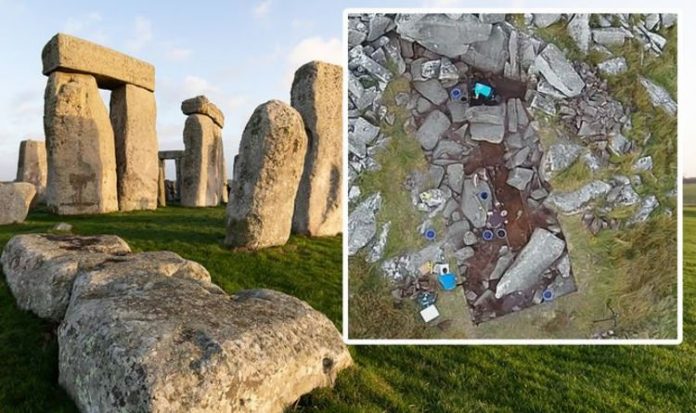Experts put forward a new theory on the ancient monument during BBC Two’s ‘Stonehenge: The Lost Circle Revealed’ documentary last week. They now believe a dismantled stone circle at Waun Mawn, in the Preseli Hills of West Wales, is likely to have been used as the original building blocks for the site that stands today in Salisbury, Wiltshire. Excavations and analysis of the site led by Professor Mike Parker Pearson of University College London dated the stone circle to around 3400BC and found several of the monoliths are of the same rock type and one of the bluestones at Stonehenge matches a hole left in Wales.
But their find could also challenge long-held views that our Neolithic ancestors transported the stones along a number of waterways.
Speaking during the documentary, Prof Parker Pearson said: “There’s been a lot of support for the sea transport theory.
“The difficulty is that, at 3000BC, we don’t think they had particularly sturdy boats that could hole these multi-tonne stones – two or three tonnes.
“It’s a very risky project indeed to manoeuvre a large megalith over water.
“It was tried in 2000, a millennium project, the stones sank within half a mile of leaving land.”
Prof Pearson’s discovery was made on the northern slopes of the Preseli Hills, “reigniting support for an alternative theory” that it would have been easier to travel by land.
Prof Parker Pearson explained: “I think there’s a much more plausible possibility that they took those stones as far as they could by land.
“There’s a much more feasible land route from the north side, going around the Preselis, and then picking up the natural routeways that have been formed by the system of valleys in South Wales.
“It’s actually the route taken by the modern A40 today.”
READ MORE: Stonehenge story ‘twist’ after 5,000-year-old charred remains of ‘Neolithic lunch’ found
Incredibly, the experiment seemed to prove the theory.
Mr Winter told viewers: “So we just pulled 1.5 tonnes by 30 13-year-olds who went 35, 40 metres up the slope – it’s up an incline.
“I think it really shows this theory works.
“You can pull a heavy weight on a sledge on raw ground without the need for huge timber arrangements and sleeper trackways or rollers.”
Experts now theorise that the stones used for Stonehenge were transported by the Neolithic civilisation to become Britain’s first “monument to unification” in 3000BC.
Radiocarbon dating previously suggested the structure was “second hand” and its smaller bluestones stood for four centuries in another location after being quarried in South Wales.
Prof Parker Pearson believes people were moving eastward and bringing their cultural “crown jewels” with them from ancestral homelands in Wales.
Waun Mawn is now being tipped as the original monument because it lies next to quarries where Stonehenge’s smaller bluestones originate, its perimeter ditch has the same diameter and is also aligned with the midsummer solstice sunrise.
Archaeologists believe this could explain why the bluestones used at Stonehenge were brought from so far away, while most circles are usually constructed within a short distance of their quarries.







